市场资讯及洞察
.jpg)
摘要
IEA 最新月报显示,全球石油需求增速放缓但仍具韧性。尽管库存持续回升,但 OECD 库存整体仍低于五年均值,市场对供应中断高度敏感。OPEC、IEA、EIA 均上调非 OPEC 供应,未来可能出现“松中带紧”的供需结构。原油价格在供应宽松预期与地缘扰动之间反复震荡,波动率下降但敏感度上升。油市表现也可能通过风险偏好外溢至能源板块、商品货币及相关市场。
一、全球原油供需前景:IEA 月报核心要点
国际能源署(IEA)最新原油月报显示,全球石油需求虽较去年降温,但整体依旧保持韧性 [1]。先进经济体消费表现好于预期,有效抵消部分新兴市场的疲弱需求。IEA 预计 2025–2026 年全球石油需求将保持温和增长。然而在供应方面,如果 OPEC+ 维持当前产量政策且需求不出现明显下滑,全球石油市场未来数个季度可能重新进入“边际紧平衡”状态。IEA 同时指出,高油价、全球经济放缓、电动车渗透等因素正在逐步压制需求增速,使油市呈现出“短期紧平衡、长期温和宽松”的结构。
二、多机构观点对比:OPEC、EIA 与 OECD 数据
三大机构对于未来市场平衡的看法存在显著差异,这主要源于对非 OPEC+ 供应增长和需求韧性的不同假设。总体来看,市场普遍认同未来供应将更加充裕,但对于过剩的规模和时间点存在分歧。

图 3:三大机构对 2025-2026 年需求与供应增长的预测对比,显示供应增长普遍超过需求增长,预示市场将进入供应过剩周期。
OPEC 的观点相对乐观。OPEC 预计 2025 年全球石油需求将增长约 130 万桶/日,2026 年略高至 140 万桶/日 [2]。与此同时,OPEC 在最新报告中连续上调非 OPEC 供给预期,并首次将 2026 年市场从“短缺”调整为“小幅过剩”,反映其判断未来供应增长可能快于需求。
EIA 的判断更偏向供应充裕。EIA 上调了美国页岩油产量预测,指出 2025 年美国原油产量将创历史新高。同时,全球供应预期被上调至日均 1.06 亿桶,高于全球消费的 1.041 亿桶,意味着未来库存可能持续累积 [3]。EIA 预期 2025–2026 年库存增加将对油价形成中期压力。
OECD 库存虽然持续回升,但仍低于五年均值。IEA 数据显示,今年全球观测库存前八个月净增约 2 亿桶,但 OECD 商业库存仍比五年均值低约 6700 万桶。整体来看,库存虽然恢复,但仍处历史偏低区间,使油市对供应中断的敏感度依旧很高。
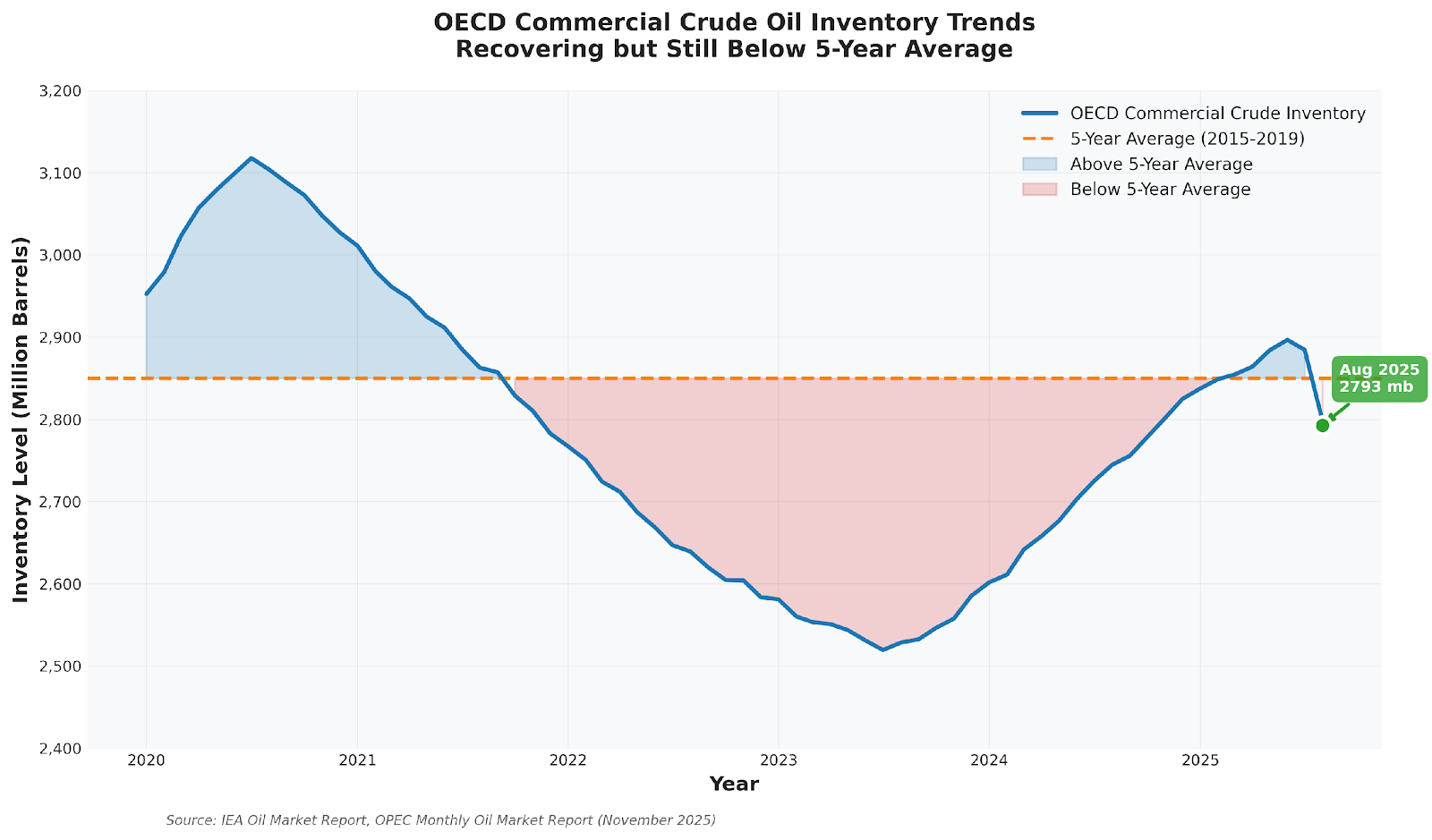
图 1:OECD 商业原油库存近 5 年对比最新水平,显示库存虽有回升但仍低于五年均值。
三、原油价格走势:WTI 与 Brent 如何消化预期
2023 年下半年,布伦特因供应紧张和地缘冲突预期一度突破每桶 90 美元。然而进入 2024–2025 年,随着供应回升和库存恢复,油价整体震荡下移。近期价格承压主要来自供应过剩预期强化以及美国库存意外上升。
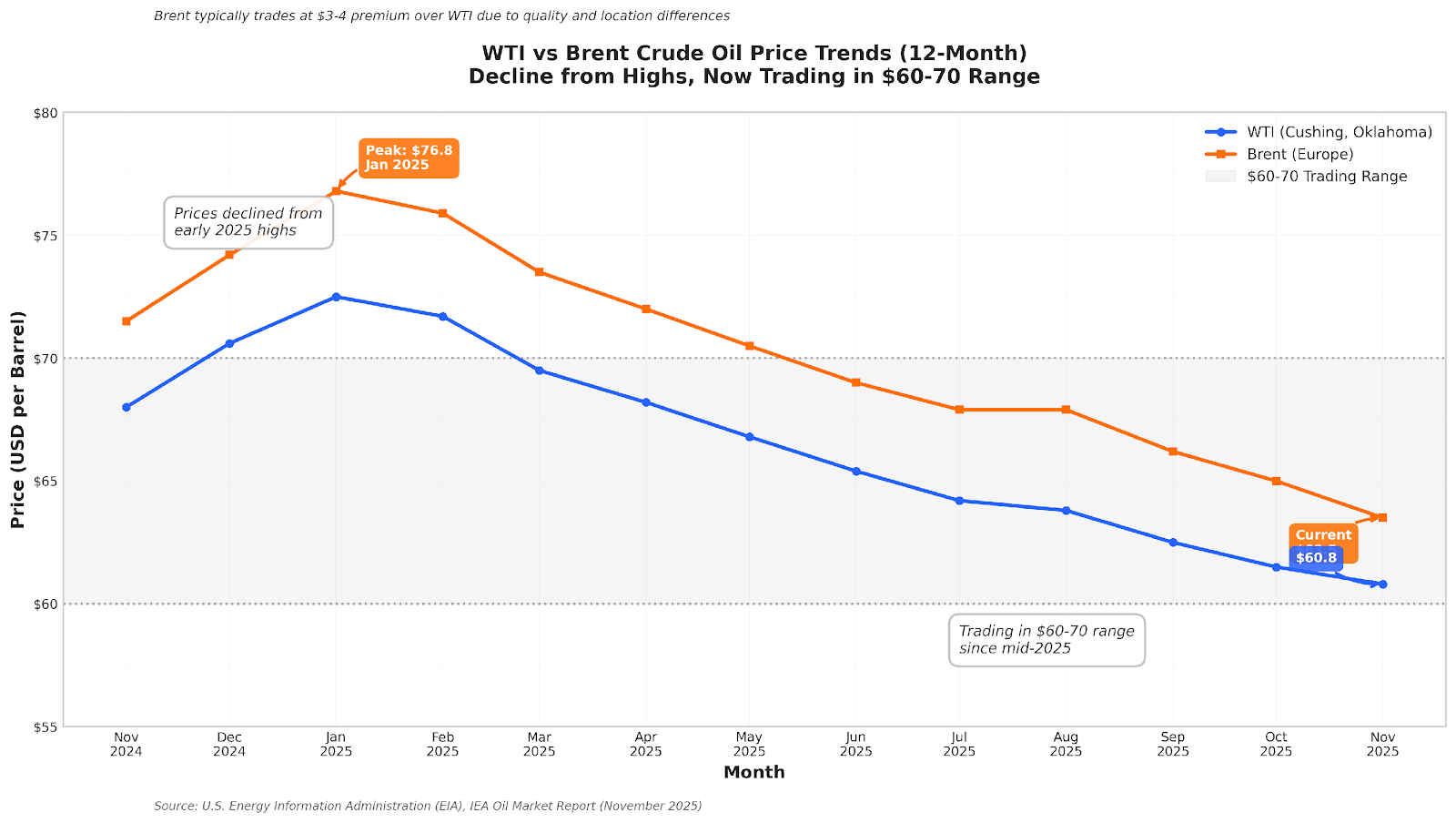
图 2:WTI 与 Brent 价格从 2025 年初的高位回落,近期在 60–70 美元区间震荡。
尽管地缘事件偶尔推升价格,但反弹难以持续,因为供应宽松的结构性预期迅速重新主导市场。WTI 与 Brent 的期限结构一度出现小幅 Contango,显示短期供应充裕压制近端价格,而远月因长期需求预期而保持相对坚挺。整体来看,油市呈现低波动、弱趋势但对消息高度敏感的特征。
四、驱动油市的关键变量:地缘政治与供应端不确定性
运输通道风险仍是油市最大的潜在冲击点之一。全球三分之一海运原油经过霍尔木兹海峡,一旦受阻便可能引发油价剧烈波动。衍生品定价显示断供概率虽低,但属于典型的“低概率、高冲击”事件。
OPEC+ 的政策滞后性也带来结构性波动。减产会压低库存、推高价格,但高油价又刺激非 OPEC 增产,使市场重新宽松。美国页岩油增速放缓进一步加剧供应端的不确定性,削弱其作为“摇摆产能”的角色。此外,俄罗斯、伊朗等国因制裁和冲突导致出口波动,更加剧油市敏感性。
五、油市变化的外溢影响
能源板块通常与油价同方向变动,但反应速度较油价更平缓。油价对风险偏好的溢出效应也容易影响澳元等商品货币。大宗商品价格上行往往提升商品出口国的贸易条件与风险情绪,而价格下跌则可能压制相关货币表现。
六、原油市场风险提示
- 数据发布风险: EIA 每周库存、IEA 与 OPEC 月报可能导致短线波动。
- 地缘政治风险: 产油区冲突、海运通道中断、制裁变化均可能影响供需平衡。
- 宏观风险: 利率政策、美元走势及全球经济增速变化都可能改变需求前景。
结语
IEA 最新展望显示,全球油市进入“边际紧平衡”阶段:库存修复但仍偏低,供应端不确定性大于需求端。在这种结构性环境下,油市会对政策、地缘事件与供给变化表现出高度敏感。理解供需框架、关注库存趋势与识别关键风险,将是未来判断油市走向的关键。
参考资料
[1] IEA (International Energy Agency). (2025, October). Oil Market Report - October 2025. https://www.iea.org/reports/oil-market-report-october-2025
[2] OPEC (Organization of the Petroleum Exporting Countries). (2025, November). Monthly Oil Market Report. https://publications.opec.org/momr
[3] EIA (U.S. Energy Information Administration). (2025, November). Short-Term Energy Outlook. https://www.eia.gov/outlooks/steo/


热门话题
欧洲的冬天快到了。在今年的9月26日,由俄罗斯向德国进行输送能源的北溪系类的天然气管道,北溪一号和二号发生了爆炸,导致了天然气的大量泄漏,这样一来,导致欧罗斯到欧洲的天然气运输出现了巨大障碍。爆炸发生之后,多个国家发表声明,这次的爆炸是人为造成的。此次的北溪天然气管道遭受了不可想象的恐怖主义袭击。

爆炸发生之后,技术人员进行了快速评估,此次爆炸造成的损坏严重,导致其在短期内难以修复。在9月27号,欧洲的天然气价格应声上涨12%。因此此次的泄漏预计将达到一周的时间,那么也就是一两周才有可能进行维修的工作,如果不能尽快修复,那么经过海水的侵蚀,三条受损的管道将无法再次投入运行。此次的泄漏时间也将直接导致超过180千吨的天然气,虽然预计不会造成温室效应,但是也是非常严重的泄露事件。现在已经到了10月份,距离冬天已经就只剩下了几周的时间,欧洲是否能挺过这个冬天呢?在之前的俄乌战争影响下,已经导致了能源危机的发生,在欧洲,天然气价格飙升,创造了历史新高。随着西方国家对俄罗斯的谴责,俄罗斯切断了大多对于欧洲的天然气供应。欧洲为了减轻对于俄罗斯天然气的依赖,其制定了一个存储目标,就是10月1号要达到80%的储气容量。目前,从储气的容量已经达到了89.6%,超过预期,对冬季天然气供应短缺的担忧有所缓解,近期价格有所下降。然而,这个储气仅仅只是为了应对目前消费问题,并不是一个长久之际。如果俄罗斯完全停止天然气的出口,或者天气变得更加寒冷,那么在2023年的3月天然气在欧洲将变成稀缺资源。因此欧盟国家已同意对能源公司的利润征收紧急税,并正在讨论是否需要在一定范围内设定天然气价格上限。其中还同意在电价高峰期强制削减5% 的用电量。根据国际能源署(IEA) 本周发布的一份报告,由于欧洲需求减少10%,预计 2022年全球天然气消费量将下降0.8%。其中就有一个重点,欧洲,到底有多依赖天然气?事实上,欧洲大陆非常依赖天然气进行发电,运输,还有供暖。在2021 年,欧洲 76%的能源是通过燃烧化石燃料产生的——天然气(34%)、石油(31%)和煤炭(11%)。

(Source:Statistical Review of World Energy)白俄罗斯是欧洲最依赖天然气的国家,其62% 的能源来自天然气,其次是俄罗斯(54%)、意大利(42%)、英国(40%)和匈牙利(39%)。包括水电、太阳能、风能和生物燃料在内的可再生能源占14%,核能占其余10%。对比非洲大陆,其仅仅只有34%的能源来自燃烧气体。所以,在俄罗斯对于天然气的供应紧缩迫使各国加速寻找替代品。那么现在的储存量怎么样。对比去年同期,储存量增加了15%。大多数的欧盟国家都有着各自的天然气储存设施,主要分布在德国,意大利、法国、荷兰和奥地利。目前德国的天然气储量为92%,法国为 97%,意大利为91%,荷兰为 92%。
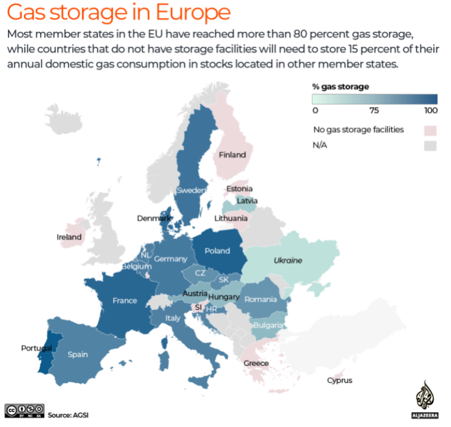
(Source:AGSI)除了应对储气挑战之外,几个欧盟国家还制定数十亿美元补贴的紧急措施,以应对飞涨的能源价格。因此,无论是俄乌战争,还是北溪设备遭到的破坏,都使得欧洲能源危机更加严峻。如果俄罗斯断供,需求不减的情况下,明年2月,欧洲天然气储存将不足20%。看来这个冬天,欧洲可能真的,会“更冷一些”。免责声明:GO Markets分析师或外部发言人提供的信息基于其独立分析或个人经验。所表达的观点或交易风格仅代表其个人;并不代表GO Markets的观点或立场。联系方式:墨尔本 03 8658 0603悉尼 02 9188 0418中国地区(中文) 400 120 8537中国地区(英文) +248 4 671 903作者:Neo Yuan | GO Markets 助理分析师


热门话题
背景介绍:当下,通胀高企与快速加息的环境下,科技股不被市场所看好,近期我们也多以介绍防守型的股票为主。但是随着科技股的整体大跌,部分股票也出现了被低估的情况。投资者们也可以做好准备,进行适当的布局,在低点抄底。毕竟,衰退与高通胀不会永远持续,科技股的寒冬总过去,但下一个机会可能是在下一个7-10 年的周期。今天,我们就先来介绍一家备受关注的科技金融公司Block。

股价:69.25上市时间:2005-05-16市值:40.2B52 周价格范围:$56.01 - $289.23行业:科技-软件-基础设施股息率:N/A公司简介:我们上一次谈到Block 是在一年前,那时它还叫Square。这个更名虽然被很多分析师所诟病,但体现出了SQ 对自身的未来规划,即“Block by Block”。SQ 的产品范围广,很难用一句话概括,其比较成熟的两个核心产品为Square 和Cash,这两个产品旨在建立一个双向数字支付生态系统。除此之外,Block 还有TIDAL,数字音乐平台; TBD,一个去中心化的交易所;Spiral,主要做Bitcoin 硬件,随着更名,产品也越来越突出。其创始人Jack Dorsey,也是Twitter 的创始人之一在投资者大会上说,Block 的宗旨就是建立一个生态系统的生态系统网络,“Ecosystems of Ecosystems” 。换言之,Block 并非要销售一个或几个产品,而是建立一个生态网络,可以不断地扩充和延展。同时,Jack Dorsey 是一个科技迷,其对Blockchain 和Bitcoin 都很有兴趣,很多人认为SQ 的更名也跟此有关。作为科技股中的软件公司,SQ 在2020 年中旬开始连续攀升至275 的高位。然而去年年底SQ 开始下跌,曾一度跌破60 美元的大关。这一方面是受大环境的影响,科技股整体承压;另一方面是Block 持有大量的比特币,受到比特币大跌的压力,SQ 的股价也进一步下跌。有Coinbase 的前车之鉴,投资者不想再押注到比特币相关的公司,因此会有60%的下跌。技术分析:可以看到SQ 的股价自去年下旬开始就一路下跌,并且一直在维加斯通道下方运行,最近一直处于横向震荡阶段。

商业模式:SQ的产品包括核心产品:Square,Cash App, 和一些新的产品:Tidal, Afterpay, TBD, Spiral。Square: Square起源于一个想法,就是让每个人的手机都可以成为信用卡读卡机。不久之后,Square发现他们的目标是要帮助商家完成整个销售流程。再后来,Square的目标升级为如何让商家销售出更多的产品。这也就形成了现在的Square生态系统,能够让中小型企业在一个平台上解决所有事情,包括:POS机,工资单,预约,商业银行业务,客户关系管理,电子商务等等。而且,Square还构建了一个应用程序编程接口(API),可以与各种平台轻松对接,比如Facebook, Instagram, QuickBooks等第三方应用程序。Sqaure一开始专注以中小企业,现在其在进军高端市场,接触更多的大型企业。其在这一方面也取得初步的成果,支付总额超过50万的卖家所带来的毛利润相较于15年增加了约19倍。Cash App:2013年, 面向商家的Square生态系统已经初步建立,那面向消费者的系统也该相应地建立起来,也就是现在的Cash App。起初,Cash App仅是让人们可以互相汇款的程序。后来,其逐渐扩大了其业务范围,如下图所示,包括:商业账户,直接存款,借记卡,比特币交易,股票交易,借款,报税方案等。随着功能的增加,Cash App所带来的收入也逐步增加,每个活跃用户所带来的毛利润从16年第四季度的5USD,到2021年第四季度,已经增加到了47USD。
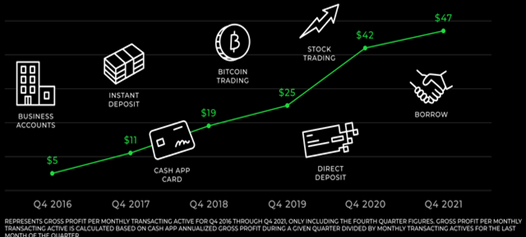
更详细的股评报告,请联系小助手获取。免责声明:GO Markets分析师或外部发言人提供的信息基于其独立分析或个人经验。所表达的观点或交易风格仅代表其个人;并不代表GO Markets的观点或立场。联系方式:墨尔本 03 8658 0603悉尼 02 9188 0418中国地区(中文) 400 120 8537中国地区(英文) +248 4 671 903作者:Jaden Wang | GO Markets 助理分析师


The EURAUD buoyed by a weaker Australian Dollar lighter lighter monetary policy from the Reserve Bank of Australia, (RBA) has seen the currency pair move with some momentum in recent days and weeks. The RBA came out in its most recent meeting and raised rates by an unexpectedly low 25 bps vs 50 bps. This helped equities and housing stability but pushed the AUD to very lows levels.
The Euro on the other hand has suffered with geopolitical conflicts and recessionary pressures that have hit major players in the Union. With Germany in particular suffering quite large inflationary issues putting severe pressure on the EUR. After to dipping to as low as 1.42 AUD in both April and August this year, the pair has been able to move back into the major range that the price has been holding since 2013, excluding the commencement of the pandemic.
Technical Analysis The weekly chart as discussed above highlight that this pair does not usually trend and if it does trend it tends not hold the trend for very long. Rather the price tends to hold a range with breaks of range usually the outcome of extreme economic events such as the GFC or the pandemic before retreating into the range. The weekly chart also indicates that the price may be ready to reverse back up as seen by the double bottom pattern that has formed.
The neckline needs to be broken by the price at 1.54 for the pattern to be confirmed. The question is whilst this price is showing signs of a reversal, the price is sitting just on a significant resistance area. The daily chart shows an interesting case for either a breakout or a breakdown.
Firstly, the price has so far not broken out completely and is still consolidating at the neckline. In addition, the price is overbought to a high level and on previous occasions when it was this overbought, it has fallen back down. However, it is possible that the RSI is also just consolidating and getting ready to breakout.
This chart needs a little bit more time to be sure of a direction, however a potential long target if it breaks out to the long side could be 1.60 and to the short side if it fails could be 1.42. With economic still to flow for both Australia and Europe the EURAUD is definitely one to keep an eye on.


Brexit 23rd June 2016 – the day the people of United Kingdom voted to leave the European Union, it’s a day which will go down in the history and will always be remembered. The margin by which people voted to leave was not big (51.9% voted to leave, 48.1% voted to stay) but it will undoubtedly continue to have a big impact on the United Kingdom, European Union and the global financial markets. What does it mean to the UK economy?
Many leading economists before the referendum had been predicting an instant and significant impact on the UK economy and consumer confidence should the country leave the European Union, but so far, these predictions have not been accurate. Latest figures show that UK gross domestic product (GDP) in volume terms was estimated to have increased by 0.7% between Quarter 3 (July to Sept) 2016 and Quarter 4 (Oct to Dec) 2016, revised up 0.1 percentage points from the preliminary estimate of GDP published on 26 January 2017. Upward revisions (due to later data received) within the manufacturing industries is the main reason (these revisions were first published as part of the Index of Production for December 2016 released on 10 February 2017).
UK GDP growth in Quarter 4 2016 saw a continuation of strong consumer spending which is in line with the Retail Sales Index for Quarter 4, which grew by 1.2% (published on 20 January 2017) and strong growth in the output of the services sector with a notable contribution in consumer-focused industries. In Quarter 4 2016, there has been a slowdown within business investment which fell by 1.0%, driven by subdued growth within the “ICT equipment and other machinery and equipment” assets. Quarterly growth and levels of GDP for the UK source: www.ons.gov.uk Currency The pound fell to a to a 31-year low and was on course for its biggest one-day loss in history on the day the people of Britain voted to leave the European Union in June and has been steadily falling against the dollar since the vote.
When Theresa May announced that the UK would begin formal Brexit negations by the end of March, it did not do much to alleviate the concerns of investors about a ‘hard’ Brexit, negatively impacting Sterling once more. But what is keeping the Pound low? It’s uncertainty, uncertainty of how Brexit will turn out.
A notable portion of participants in the Forex market is made up of speculators and the consensus outlook they hold for a currency sometimes has a significant impact on its overall value, regardless of the impact from companies and individuals looking to move money for practical purposes. GBP/USD since the Brexit vote source: www.tradingview.com It is hard to predict to how, when or if, pound sterling will recover but there are some key things to keep an eye out for. > There could be a strong positive movement for pound sterling if the United Kingdom get a favourable exit deal with the European Union. > The Bank of England is not likely going to cut interest rates any further in the near term or put more money in the economy and that will be viewed as signs of confidence in the UK and will most likely make the pound more attractive. > UK Economic data will continue to have a significant impact on Sterling. If enough data suggests that the United Kingdom is in a strong position going into Brexit, for example if companies are continuing to hire and invest in the British economy and not planning to relocate to other EU countries, we should see renewed optimism in Sterling.
Meanwhile, stock markets have been strong since the Brexit vote. The FTSE100 closed at a record high at the end of 2016, up 14.4% during the year. FTSE100 since the Brexit vote Source: www.tradingview.com Key dates this month worth noting in the diary: Tuesday March 7 Deadline to pass the Brexit Bill - The May government wants the Lords to approve the Brexit bill by Tuesday March 7.
It will then need royal assent to become law. Thursday March 9 and Friday March 10 EU Summit: Should the bill pass in time, British Prime Minister May could decide to trigger Article 50 in Brussels. Friday March 31 The Prime Minister has publicly said that she plans to trigger Article 50 by the end of March 2017.
Triggering Article 50 will be followed by the arduous two-year process of the UK's break up with the EU.


热门话题
美联储:叫地主!澳联储:不抢
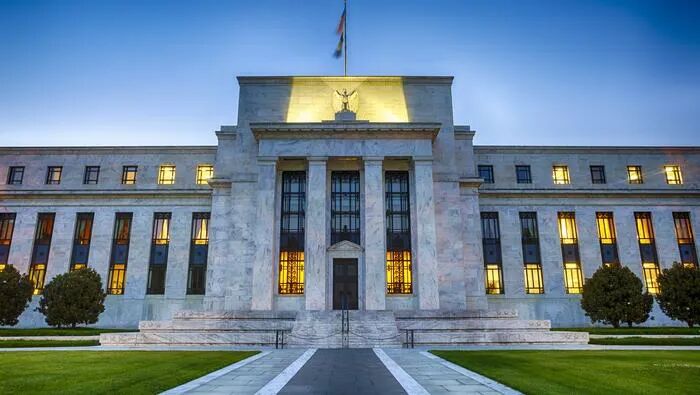
昨天,澳联储公布了最新的利率决议,加息25个基点,将现金利率提高至2.60%,低于市场预期的50个基点,这也是澳联储继连续3次50个基点的加息之后,首次减缓加息幅度。在美国快节奏大力度的强势加息政策下,澳联储跟不起了。

澳联储主席罗威在会议中声明,目前澳大利亚的经济继续稳健增长,劳动力市场非常紧张,许多公司在招聘工人方面遇到了困难,8月份的失业率为3.5%,约为进50年来的最低水平,并且,职位空缺和招聘广告都处于非常高的水平,这表明在未来的几个月内,失业率将进一步下降;物价稳定是经济发展的先决条件,因此澳联储的首要任务是将通胀控制在2%-3%的范围之内,预计在未来的一段时间之内,澳联储将进一步提高利率,这是使通胀回落的必要条件,澳联储仍然坚定决心将通胀恢复到目标水平,并将采取必要措施实现这一目标。从这份声明中不难看出澳联储依旧是要加息的,只不过加息的力度可能就此减弱,一方面是澳洲的通胀数据并没有美国那么夸张,再有就是澳洲的经济实力也不允许像美国那样的加息力度和频率。或许此次议息会议将会是澳联储加息进程的转折点,加息力度开始放缓。这突如其来的好消息让澳洲股市几乎全线上涨,涨幅最夸张的当属锂矿股,CXO上涨近12%,LRS涨超过14%,四大银行股平均涨幅也都超过了4%,其中ANZ涨幅最大,达4.96%。这其实也解释了很多朋友的一个疑虑,就是加息幅度在50个基点的时候,为什么银行股不涨反跌,反倒是加息力度减小的时候,银行股开始上涨。并不是利率越高,银行的收益越高,在整体货币环境较为宽松的时候,企业的发展是比较容易的,当加息开始放缓时,市场永远是先与政策的,市场就会觉得金融环境在逐渐的放宽,对于未来也更加的乐观,因此,ASX200 收涨2.17%,上涨140多点。

货币方面,澳元兑美元在澳洲加息不及预期后,短线下跌超60个点,但在随后的几个小时内,基本收复了跌幅;美元指数出现了一定的下跌,但在大周期来看,仍然处于上升趋势;截止发稿时,黄金价格站上1700整数关口,美国原油涨至84美元/桶,美元距离110.7-111附近的支撑越来越近。由于近期欧洲局势的不确定性,避险货币在遇到风险事件的时候,很有可能会再次走高,并且结合目前美国的加息周期,美元依旧是有走高的趋势的,短期的回调可以给我们提供一些机场机会,美元指数依旧值得我们关注。免责声明:GO Markets分析师或外部发言人提供的信息基于其独立分析或个人经验。所表达的观点或交易风格仅代表其个人;并不代表GO Markets的观点或立场。联系方式:墨尔本 03 8658 0603悉尼 02 9188 0418中国地区(中文) 400 120 8537中国地区(英文) +248 4 671 903作者:Rick Shao | GO Markets 专业分析师


Tesla Inc. (NASDAQ: TSLA) reported its Q3 2022 delivery numbers on Sunday. World’s largest automaker delivered a total of 343,830 cars (up by 42.49% year-over-year) in the third quarter – setting a new quarterly record. The deliveries in Q3 consisted of: 18,672 Model S/X 325,158 Model 3/Y The automaker produced 365,923 vehicles in Q3. ''Historically, our delivery volumes have skewed towards the end of each quarter due to regional batch building of cars.
As our production volumes continue to grow, it is becoming increasingly challenging to secure vehicle transportation capacity and at a reasonable cost during these peak logistics weeks. In Q3, we began transitioning to a more even regional mix of vehicle builds each week, which led to an increase in cars in transit at the end of the quarter. These cars have been ordered and will be delivered to customers upon arrival at their destination,'' the company said in the press release.
Tesla will report its Q3 financial results after the closing bell on Wednesday, October 19, 2022. Tesla Inc. (NASDAQ: TSLA) chart Shares of Tesla were down by around 6% on Monday at $247.90 per share. Stock performance 1 month: -1.84% 3 month: +71% Year-to-date: -24.70% 1 year: +65% Tesla price targets JP Morgan: $153 Piper Sandler: $340 Deutsche Bank: $400 Wolfe Research: $360 Jefferies: $350 Morgan Stanley: $383 Wedbush: $360 Tesla is the 6 th largest company in the world and with a total market cap of $825.19 billion.
You can trade Tesla Inc. (NASDAQ: TSLA) and many other stocks from the NYSE, NASDAQ, HKEX and the ASX with GO Markets as a Share CFD. Sources: Tesla Inc., GO Markets MT5, Benzinga, CompaniesMarketCap

